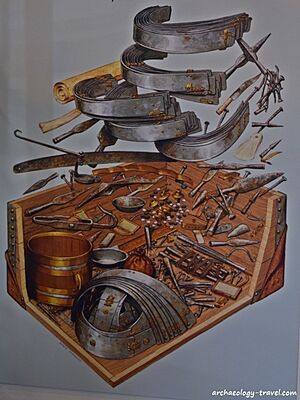Corbridge Hoard facts for kids
The Corbridge Hoard is a special collection of mostly iron objects. It was found in 1964 at a Roman site called Coria, near Corbridge in Northumberland, England. This amazing discovery helps us learn a lot about Roman times!
The hoard was buried between the years 122 AD and 138 AD. It was found in the main buildings of an early Roman fort, which later became a Roman town.
Contents
What Was Inside the Corbridge Hoard?
The Corbridge Hoard was buried in a strong wooden chest. This chest was covered in leather and had iron bands around it. Inside, there were many different items made from iron, steel, copper, lead, stone, glass, and even some natural materials.
The Famous Roman Armour
The most exciting discovery in the hoard was parts of Roman armour called 'lorica segmentata'. This type of armour was made of metal strips joined together. The hoard contained pieces that could make up at least three full sets of armour, or parts of twelve sets!
Before this hoard was found, experts knew about this armour but didn't know how it was put together. The Corbridge Hoard showed them exactly how it worked. It was a huge help for understanding Roman soldiers' gear!
Other Cool Items Found
Besides the armour, the Corbridge Hoard had many other interesting things:
- Bundles of spearheads, still tied together with string.
- Bolts for a Roman war machine called a ballista (like a giant crossbow).
- A scabbard for a sword (the case that holds a sword).
- Different tools, like a pulley and a lamp.
- Items for carpentry, such as nails and special clamps called 'joiner's dogs'.
- A small wooden bucket or mug.
There were also tiny pieces of feathers, which might have been from cushions or helmet decorations. Amazingly, some fragments of wax writing tablets and even papyrus (an early form of paper) were found. Finding papyrus in Roman Britain is very rare!
How the Items Were Saved
Many of the natural items in the hoard, like the wooden chest and the feathers, usually would have rotted away. But they were saved by a process called mineralization. This happened because the iron and steel objects in the chest rusted. The rust helped to preserve the other materials around them.
Why Was the Hoard Buried?
Experts have different ideas about why the Corbridge Hoard was buried:
- Some think it was hidden quickly because enemies were attacking.
- Others believe it was buried on purpose to collect rust and a green substance called verdigris, which Romans used for medicine.
- Another idea is that it was rubbish from a workshop. When the Roman soldiers moved to a new place, they might have buried these materials to stop enemies from using them.
Where to See the Corbridge Hoard
You can see parts of the Corbridge Hoard at the Corbridge Roman Site museum. Some other pieces are on display at the Great North Museum in Newcastle upon Tyne.
Since August 2012, the Corbridge Roman Site has a new display for the hoard. It includes a copy of the armour, so you can imagine how it looked. There's also a film with never-before-seen footage of the hoard being dug up in 1964!


